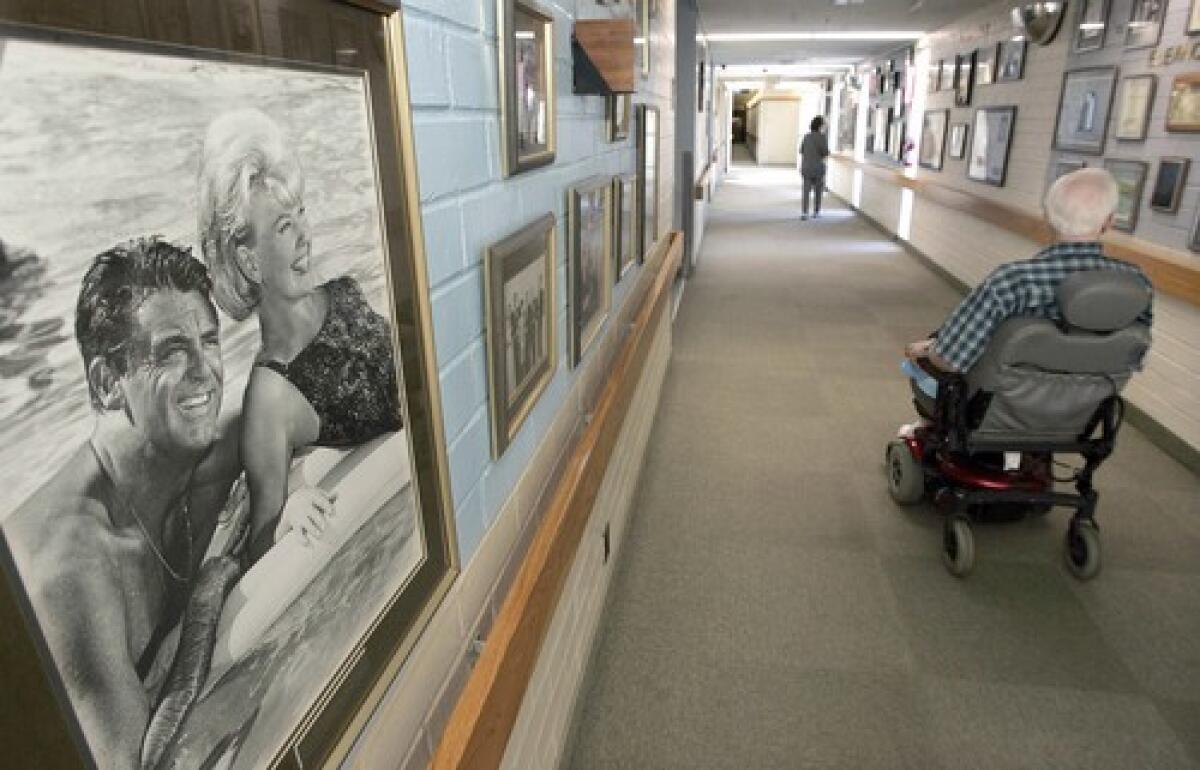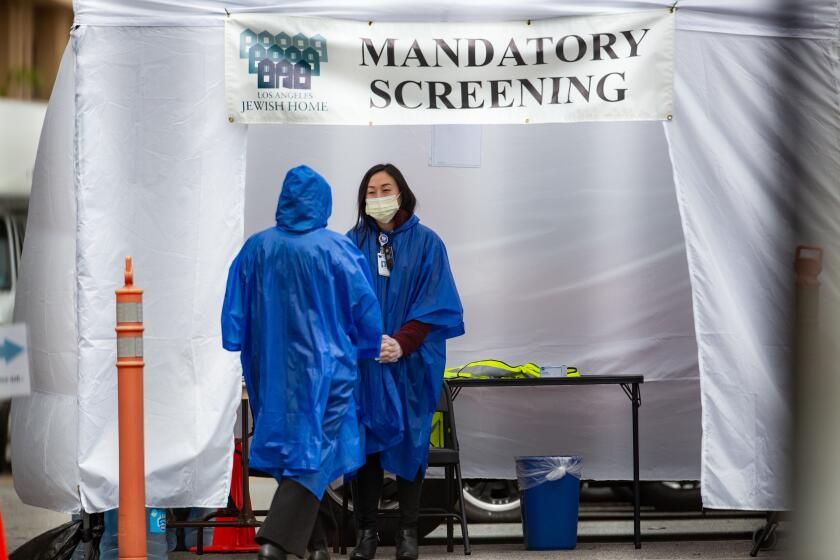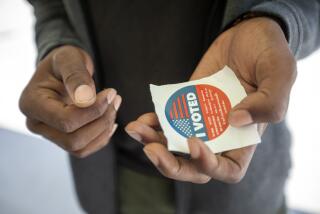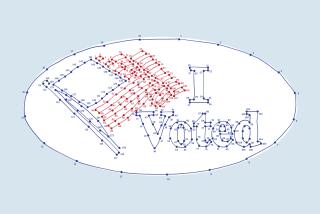Nursing home residents want to vote, but amid a pandemic, it is harder than ever

- Share via
The convergence of the COVID-19 pandemic and election season has complicated this year’s voting for residents of nursing homes, assisted living facilities and other long-term care centers.
Many seniors who need help to get or fill out their ballots may be stymied by shifting rules about family visits. Voting procedures — whether in person or by mail — are under increased scrutiny, adding to the confusion. Facilities that used to host voting precincts probably won’t do so this year because of concerns about the spread of COVID-19.
“We’re basically not allowed to go out into the public right now, we’re more vulnerable, and our immune systems are compromised anyway,” said Janice Phillips, a 14-year resident of Village Square Healthcare Center, a skilled nursing facility in San Marcos, Calif. “We’re basically locked in.”
Phillips, 75, who has rheumatoid arthritis, has voted by absentee ballot for years without problems. This year, she is encouraging her fellow residents to vote by mail as well. She works with the facility’s activities staff, going resident by resident, to make sure folks are registered. As president of the resident council, Phillips has also raised the issue at community meetings.
Older Americans are a consistent voting bloc courted by both major political parties.
According to AARP, 71% of Americans 65 and older voted in the 2016 presidential election, compared with 46% of people 18 to 29.
“For many older adults, it’s a point of pride for them that they’ve voted in every election since they were 18,” said Leza Coleman, the executive director of California’s Long-Term Care Ombudsman Assn.
But hardly anyone has been allowed inside skilled nursing facilities since the start of the pandemic, except for staff members and the occasional state health official, or family members in certain circumstances. In California and beyond, facilities are beginning to open up in counties with low transmission rates, since federal rules changed in September to allow more lenient visiting policies.
At the same time, outbreaks continue to plague some senior facilities, despite improved testing of staff and other safety measures. On Wednesday, Santa Cruz County health officials reported a major outbreak at the Watsonville Post-Acute Center, which has infected 46 residents, killing nine of them; 15 staff members were infected.
Nursing homes were ground zero for coronavirus infections and deaths early in the pandemic. Now some are grappling again with widespread infections and deaths.
California officials are pressing nursing homes and senior centers to give residents who want to vote the opportunity. The Department of Public Health on Oct. 5 sent a letter to all those facilities, explaining they have an obligation to inform and assist residents with voting, including what actions are permissible for staffers to undertake in helping voters. It also includes advice about maintaining a safe environment through the election by limiting nonessential visitors, properly using protective gear such as gloves and handling ballots as little as possible.
In years past, civic groups such as the League of Women Voters would stop by to give presentations on what’s on the ballot. Candidates for local office would hit nursing homes to make pitches.
“In the context of a pandemic, we just can’t do it this year,” said Michelle Bishop, voter access and engagement manager with the National Disability Rights Network.
Before the pandemic, nursing homes and assisted living facilities also often served as polling places. Residents could easily access voting booths, often set up in a lobby or community room. That was especially important because nursing homes are likely to be accessible to people with mobility problems, Bishop said.
Otherwise, facilities would often organize bus trips and outings to polling places.
In California, the last day to register to vote online or by mail is Oct. 19, though voters can register in person up to and including election day. All registered voters will receive a ballot in the mail, and those postmarked by Nov. 3 will still be counted in California for 17 days after the election. Advocates say it’s important for newer residents at skilled nursing facilities to make sure they’ve registered at their new address or have plans to get their ballot delivered to them from their former homes.
Other states are also sending ballots to all registered voters by mail this year on various time frames. All states permit seniors or people who have trouble reaching polling stations to request an absentee ballot.
Once they have a ballot in hand, some older adults need help from family or staff at their facilities to complete it correctly and send it back to election officials. The federal directive to relax visiting rules could ease some of that pressure, but the situation varies by facility. For people whose relatives cannot help them, it may fall to staff members to set up calls and video chats between residents and their families, or provide the assistance to residents themselves.
Some states don’t allow nursing home staffers to help with ballots to avoid influencing votes. Even if they can assist, employees may be stretched too thin to help. In a year when nursing home staff members are spending an extra hour each day putting on protective gear, there isn’t always extra time to make sure every resident is registered and voting, said Dr. Karl Steinberg, chief medical officer for Mariner Health Central, a nursing home management company in California.
“There’s a perennial workforce shortage in nursing homes, and it’s been exacerbated by this” pandemic, Steinberg said. “This year, with all the chaos, there may be less staff time available to help people with voting.”
Tracy Greene Mintz, whose business, Senior Care Training, trains senior care workers, is responsible for staffing at 100 nursing homes in California. She said she started ringing alarm bells about voting rights in August.
“Elected officials do not care about nursing homes, period,” Greene Mintz said. “They assume residents don’t vote and don’t make contributions.”
She asked the California Department of Public Health, which surveys skilled nursing facilities every six weeks about COVID-19 infection control, to add a question on how facilities were planning for elections. The department declined.
So she set up webinars with facility administrators and the Los Angeles County registrar-recorder/county clerk to go over information on how to submit and track absentee ballots.
She has also urged state officials to provide a statewide plan that facilities could use as a blueprint. She wrote one herself that was emailed out by a trade group, the California Assn. of Health Facilities.
Still, California is in better shape than some other states, said Raúl Macías, a lawyer with the Democracy Program at the Brennan Center for Justice, a law and public policy institute. Elsewhere, residents may have to apply for an absentee ballot, and sometimes must provide a reason they can’t vote in person.
State inspectors worry they could be unwittingly spreading coronavirus from nursing home to nursing home while doing their jobs.
California also has the Voter Bill of Rights, which allows individuals to designate someone to help them fill out and drop off their ballot. In some states, such as North Carolina, assistance can come only from designated bipartisan voting assistance teams, which may be harder to recruit during a pandemic, Macías said.
No matter the state, state and county election officials and facility administrators should draft voting plans, said Bishop, of the Disabilities Rights Network. That would help staff know the proper way to assist residents without influencing their votes, and residents know their voting rights.
“There is a bit of a gray area on whose responsibility this is,” Bishop said. “It’s one of the years when we start asking, ‘Whose responsibility is it?’ Who cares? We have to get it done.”
If they can’t get access to ballots or need help, California residents can contact the state’s long-term care ombudsman program, which can investigate complaints, help them resolve the issue and take the problem to the Department of Public Health if it can’t be fixed.
This story was produced by KHN (Kaiser Health News), which publishes California Healthline, an editorially independent service of the California Health Care Foundation. KHN is not affiliated with Kaiser Permanente.
More to Read
Sign up for Essential California
The most important California stories and recommendations in your inbox every morning.
You may occasionally receive promotional content from the Los Angeles Times.












